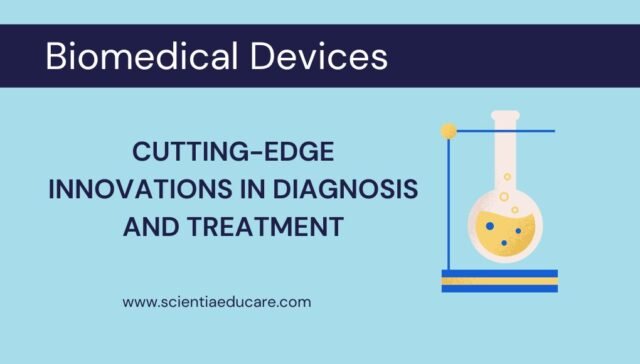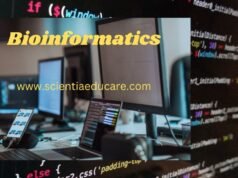Biomedical Devices: Cutting-Edge Innovations in Diagnosis and Treatment
Introduction
Biomedical devices have revolutionized healthcare by improving the accuracy of diagnosis, enhancing treatment efficiency, and enabling personalized medicine. These innovations range from wearable health trackers to advanced imaging systems and robotic-assisted surgeries. This study module explores various biomedical devices, their innovations, and their impact on healthcare.
Innovative biomedical diagnostic tools,
Latest wearable health devices,
AI-powered medical treatments,
Smart prosthetics for mobility,
Affordable biomedical imaging solutions.
1. Understanding Biomedical Devices
Biomedical devices are instruments, machines, or implants designed to diagnose, prevent, monitor, or treat medical conditions. They play a crucial role in modern healthcare by enabling early disease detection, improving surgical outcomes, and enhancing patient management.
Types of Biomedical Devices
- Diagnostic Devices – MRI scanners, CT scanners, ECG machines
- Therapeutic Devices – Pacemakers, insulin pumps, dialysis machines
- Assistive Devices – Prosthetics, hearing aids, mobility aids
- Wearable Devices – Smartwatches, fitness trackers, ECG monitors
2. Innovations in Biomedical Devices
Recent advancements in biomedical technology have led to groundbreaking developments in both diagnosis and treatment.
a. Diagnostic Innovations
i. AI-Powered Imaging Systems
Artificial Intelligence (AI) has enhanced diagnostic imaging by improving the accuracy of detecting abnormalities in radiological scans. AI-integrated MRI and CT scanners help radiologists identify tumors, fractures, and other conditions faster.
ii. Lab-on-a-Chip Technology
This miniaturized laboratory system allows rapid and cost-effective disease testing. Lab-on-a-chip devices are used for detecting infectious diseases, cancer markers, and genetic disorders.
iii. Smart Biosensors
Smart biosensors provide real-time monitoring of biomarkers for diseases like diabetes and cardiovascular conditions. These devices help in early disease detection and monitoring without the need for frequent hospital visits.
b. Therapeutic Innovations
i. 3D-Printed Medical Implants
3D printing has enabled the creation of customized prosthetics, dental implants, and even organ scaffolds, improving the comfort and efficiency of medical implants.
ii. Robotic-Assisted Surgery
Robotic surgery, such as the Da Vinci Surgical System, enhances precision and minimizes human error in procedures like cardiac and orthopedic surgeries.
iii. Bioelectronic Medicine
Bioelectronic devices use electrical signals to treat diseases, such as vagus nerve stimulators for epilepsy and depression.
3. Impact of Biomedical Devices on Healthcare
a. Early Disease Detection
- Devices like AI-based imaging and biosensors allow for early diagnosis of critical conditions such as cancer and neurological disorders.
b. Enhanced Patient Monitoring
- Wearable devices provide continuous health monitoring, reducing hospital readmissions and allowing patients to manage chronic conditions more effectively.
c. Improved Surgical Outcomes
- Robotics and AI-assisted procedures ensure minimal invasiveness, quicker recovery, and reduced risk of complications.
4. Challenges and Future Trends
a. Challenges
- High Costs – Advanced biomedical devices require significant investment.
- Regulatory Approvals – Devices must meet stringent FDA and CE Mark regulations.
- Data Security – With the rise of AI and IoT, cybersecurity concerns are increasing.
b. Future Trends
- AI and Machine Learning Integration – AI-driven diagnostics will become more precise and widely adopted.
- Wearable Tech Expansion – More personalized and predictive healthcare solutions.
- Bioprinting and Regenerative Medicine – Development of 3D-printed organs for transplantation.
5. Relevant Website URLs for Further Reading
For more insights on biomedical devices and their innovations, visit the following websites:
- U.S. Food and Drug Administration (FDA) – Medical Devices
- National Institute of Biomedical Imaging and Bioengineering (NIBIB)
- World Health Organization – Medical Devices
- MedTech Europe – Biomedical Innovations
- NIH – Bioengineering Research
Conclusion
Biomedical devices are at the forefront of medical advancements, transforming the way diseases are diagnosed and treated. As technology continues to evolve, the integration of AI, robotics, and biotechnology in healthcare will lead to more efficient, personalized, and accessible medical solutions. Continued research and regulatory support are essential to ensure the widespread adoption of these innovations, ultimately improving global healthcare outcomes.
MCQs with answers and explanations on ‘Biomedical Devices: Innovations in Diagnosis and Treatment’
1. What is the primary function of a pacemaker?
A) Monitor blood sugar levels
B) Regulate heartbeats ✅
C) Assist in lung function
D) Measure blood pressure
Explanation: A pacemaker is a small device implanted in the chest to help regulate abnormal heart rhythms by sending electrical impulses to the heart.
2. MRI (Magnetic Resonance Imaging) primarily relies on which physical principle?
A) X-rays
B) Nuclear magnetic resonance ✅
C) Ultrasound waves
D) Infrared radiation
Explanation: MRI uses a strong magnetic field and radio waves to generate images of internal body structures based on nuclear magnetic resonance (NMR) principles.
3. Which biomedical device is used for blood glucose monitoring?
A) Sphygmomanometer
B) Glucometer ✅
C) Electrocardiogram
D) Stethoscope
Explanation: A glucometer is a portable device that measures blood glucose levels, essential for diabetic patients.
4. What is the role of an electrocardiogram (ECG) machine?
A) Measure lung capacity
B) Record brain activity
C) Measure electrical activity of the heart ✅
D) Monitor kidney function
Explanation: An ECG records the electrical signals in the heart to diagnose various heart conditions.
5. Which biomedical device is essential for assisting patients with kidney failure?
A) MRI Scanner
B) Dialysis Machine ✅
C) CT Scanner
D) Defibrillator
Explanation: A dialysis machine removes waste, excess fluids, and toxins from the blood when the kidneys fail.
6. The primary purpose of a cochlear implant is to help individuals with:
A) Heart failure
B) Diabetes
C) Hearing loss ✅
D) Paralysis
Explanation: A cochlear implant is an electronic device that helps individuals with severe hearing loss by bypassing damaged parts of the ear.
7. A defibrillator is used to:
A) Measure oxygen levels in blood
B) Restart the heart during cardiac arrest ✅
C) Monitor blood sugar levels
D) Detect brain tumors
Explanation: A defibrillator delivers an electric shock to restore normal heart rhythm during cardiac arrest.
8. Which medical imaging technique uses X-rays to produce detailed cross-sectional images of the body?
A) MRI
B) CT Scan ✅
C) Ultrasound
D) PET Scan
Explanation: A CT scan (Computed Tomography) combines X-ray images taken from different angles to create detailed cross-sectional images.
9. What does an insulin pump do?
A) Measures blood pressure
B) Delivers insulin to diabetic patients ✅
C) Measures lung function
D) Monitors ECG
Explanation: An insulin pump is a small device that continuously delivers insulin to help regulate blood sugar levels in diabetics.
10. Which device is used to measure blood pressure?
A) Glucometer
B) Stethoscope
C) Sphygmomanometer ✅
D) Dialysis Machine
Explanation: A sphygmomanometer measures blood pressure using an inflatable cuff and a gauge.
11. PET (Positron Emission Tomography) scans are mainly used for:
A) Monitoring kidney function
B) Detecting metabolic activity in tissues ✅
C) Measuring heart rate
D) Checking blood pressure
Explanation: PET scans use radioactive tracers to observe metabolic processes and detect diseases like cancer and neurological disorders.
12. What is the function of an endoscope?
A) Visualize internal body parts ✅
B) Monitor heartbeats
C) Measure glucose levels
D) Detect brain activity
Explanation: An endoscope is a flexible tube with a camera used to examine the gastrointestinal tract and other internal structures.
13. Which biomedical device is commonly used during pregnancy for fetal monitoring?
A) Ultrasound Scanner ✅
B) MRI Scanner
C) Glucometer
D) Pacemaker
Explanation: Ultrasound imaging is used to monitor fetal development and detect potential abnormalities.
14. What type of imaging technique is used in mammography?
A) X-rays ✅
B) MRI
C) PET Scan
D) Ultrasound
Explanation: Mammography uses X-rays to detect breast cancer and other abnormalities.
15. The bionic eye is designed to assist individuals with:
A) Hearing loss
B) Blindness ✅
C) Heart disease
D) Kidney failure
Explanation: A bionic eye is a retinal implant that provides visual perception to people with severe vision loss.
16. The Da Vinci Surgical System is used for:
A) Automated drug delivery
B) Robotic-assisted surgery ✅
C) Monitoring diabetes
D) Diagnosing tuberculosis
Explanation: The Da Vinci system enhances precision in complex surgeries through robotic-assisted techniques.
17. Which device helps in non-invasive oxygen level measurement?
A) Ventilator
B) Pulse Oximeter ✅
C) ECG Machine
D) Defibrillator
Explanation: A pulse oximeter measures oxygen saturation levels in the blood using light absorption.
18. Which medical imaging technique is safest for pregnant women?
A) X-ray
B) MRI
C) Ultrasound ✅
D) CT Scan
Explanation: Ultrasound does not use radiation and is safe for fetal imaging.
19. Which material is commonly used for making artificial heart valves?
A) Plastic
B) Titanium
C) Stainless steel
D) Biocompatible polymers and metals ✅
Explanation: Artificial heart valves are made from biocompatible materials to function effectively without causing rejection.
20. A ventilator primarily assists in:
A) Pumping blood
B) Respiration ✅
C) Digestive processes
D) Liver function
Explanation: A ventilator helps patients breathe when they cannot do so on their own.
21. The main purpose of a prosthetic limb is:
A) Improve heart function
B) Replace a missing limb ✅
C) Enhance lung capacity
D) Monitor glucose levels
Explanation: Prosthetic limbs restore mobility and function for individuals with limb loss.














